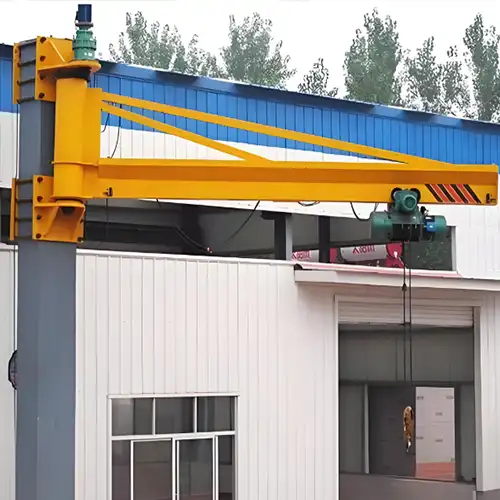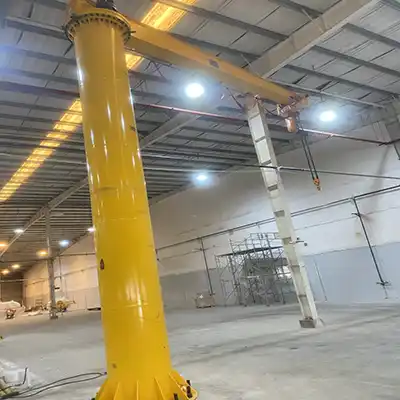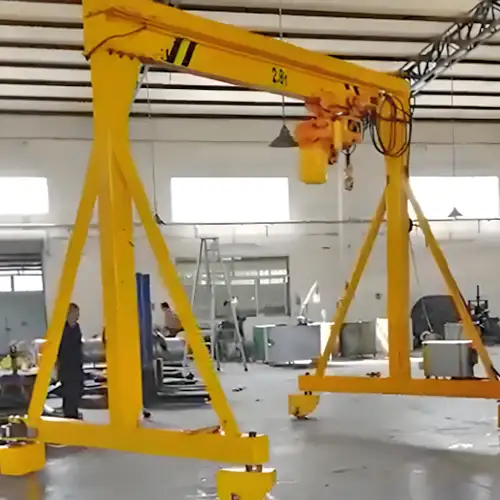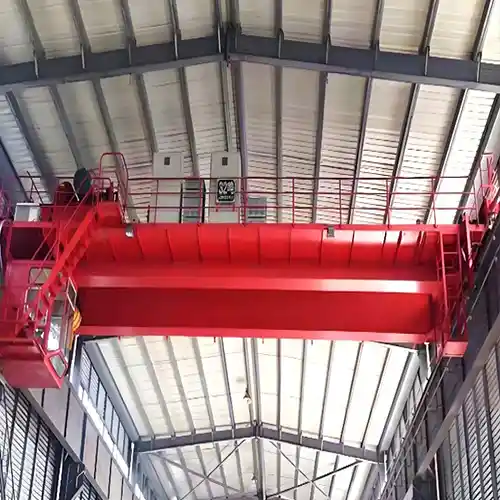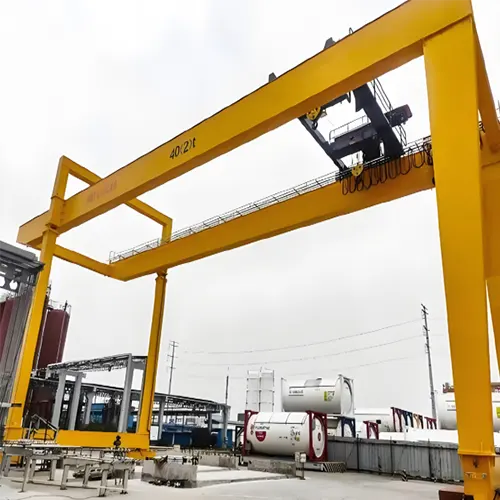Your Trusted Jib Crane Manufacturer & Supplier
Automotive Production with 5 Ton Wall-Column Mounted Jib Cranes
5 ton wall-column mounted jib cranes enhance automotive production by improving material handling efficiency, precision, and workspace flexibility in assembly lines.
Overview of Wall-Column Mounted Jib Cranes in Automotive Production
Wall-column mounted jib cranes are widely used in automotive production lines to handle the lifting and movement of heavy components such as car body parts, engines, transmissions, and chassis. These cranes are mounted directly to a wall or column, saving valuable floor space while maintaining high lifting capacity. The ability to rotate around a fixed point allows operators to maneuver loads with precision and flexibility, especially in tight or confined spaces.
- Space-Saving Design: Wall-mounted structure minimizes the need for floor supports.
- Rotational Flexibility: Cranes can move loads in a 360-degree range around a fixed column.
- Ideal for Confined Spaces: Perfect for areas with limited space where traditional cranes would be cumbersome.
These cranes are essential for maximizing workspace in busy automotive manufacturing environments while still providing the necessary strength to move large and heavy automotive components. Their compact design allows for efficient use of space, making them an optimal solution for high-density production areas.
Importance in Automotive Production Lines
In automotive production lines, maintaining a constant and efficient workflow is key to meeting production targets. Wall-column mounted jib cranes are vital in ensuring that large, heavy parts are easily lifted, moved, and positioned without disrupting the flow of operations.
- Increased Efficiency: Enables fast, precise lifting and moving of components.
- Reduced Manual Labor: Minimizes the need for manual lifting, improving worker safety.
- Space Optimization: Wall-mounted design frees up valuable floor space for other operations.
These cranes ensure that automotive parts are moved seamlessly from one part of the production line to another, contributing to faster assembly times and fewer delays. They help to streamline the production process, reducing downtime and maintaining a high level of productivity throughout the plant.
Key Role of 5 Ton Jib Cranes
Focus on 5 Ton Capacity and Its Versatility in Heavy Lifting
The 5 ton capacity of wall-column mounted jib cranes is particularly beneficial in automotive manufacturing, where heavy components need to be lifted and transported frequently. A 5 ton crane can easily handle large automotive parts, such as engine blocks, transmissions, and car body panels, making it an ideal choice for a wide range of tasks.
- Handles Heavy Loads: Ideal for lifting large components such as engines, chassis, and body parts.
- Versatile Lifting: Can be used in various stages of production, including assembly, inspection, and repair.
- Compact Yet Powerful: 5 tons provides enough lifting power without requiring a larger, more expensive system.
The 5 ton capacity strikes a perfect balance between lifting capability and practicality. It's large enough to handle most components in automotive production but not so large as to be inefficient or require unnecessary overhead costs. The versatility of the crane makes it adaptable to different tasks, from moving car bodies along the assembly line to lifting and positioning engines and other heavy parts.
How These Cranes Contribute to Overall Production Efficiency
Wall-column mounted jib cranes are a key factor in improving the overall efficiency of automotive production lines. Their ability to lift and move heavy loads quickly and accurately helps keep the production flow uninterrupted, minimizing downtime and increasing throughput.
- Streamlines Workflow: Quick and precise movement of parts reduces waiting times and bottlenecks.
- Improves Safety: Reduces manual lifting, preventing worker injuries.
- Boosts Productivity: Keeps the production line running smoothly and efficiently.
These cranes also reduce the risk of part damage, as they allow for more controlled lifting and placement of sensitive components, such as engine parts. By reducing the need for workers to manually lift heavy items, they help to improve overall workplace safety, leading to fewer injuries and less downtime.
Additionally, the compact design of the wall-column mounted jib crane ensures that production lines can be optimized for maximum output. By using less floor space, more room is available for other essential machinery, assembly stations, or additional production lines.
In conclusion, 5 ton wall-column mounted jib cranes play an important role in optimizing automotive production. They provide the necessary strength and flexibility to handle heavy loads, while their compact design and safety features help improve workflow efficiency, worker safety, and overall productivity in the automotive manufacturing environment.
The Importance of Jib Cranes in Automotive Manufacturing
Supporting Heavy Loads in Automotive Production
Key Components Handled: Car Body Parts, Engines, Transmissions, Chassis, etc.
In automotive manufacturing, managing the movement of heavy components is crucial to maintaining a smooth production flow. Jib cranes play an essential role in lifting and transporting various large and heavy parts used in the production of vehicles. These components include car body panels, engines, transmissions, chassis, and other critical parts.
- Car Body Parts: Lifting large, often bulky parts such as doors, hoods, and panels.
- Engines & Transmissions: Handling heavy engine blocks and transmission units with precision.
- Chassis & Subassemblies: Moving car chassis and subcomponents with ease.
The 5 ton capacity of wall-column mounted jib cranes is ideal for these types of heavy lifting tasks. With the ability to handle components ranging from several hundred kilograms to several tons, these cranes ensure that all parts are lifted and positioned safely without requiring additional manual labor or heavy machinery.
Load Handling Capacity of 5 Tons: Benefits for Heavy Lifting
The 5 ton capacity of these cranes strikes the perfect balance between strength and versatility in automotive manufacturing. Most automotive parts, including engines, transmissions, and car body components, often fall within this weight range, making the 5 ton jib crane ideal for handling them.
- Adequate Lifting Power: 5 tons provides sufficient capacity for the majority of automotive components, including large body parts and engine blocks.
- Versatility: Capable of lifting different types of components throughout the production line without the need for multiple lifting systems.
- Cost-Effective: A 5 ton crane offers the necessary lifting power without the expense of a larger, more costly lifting system.
This capacity allows automotive plants to keep production lines moving smoothly while maintaining cost efficiency and minimizing the need for additional, larger cranes that would take up more space and incur higher operational costs.
Efficient Workspace Management
Maximizing Available Space in Production Facilities
In automotive manufacturing, space optimization is critical. Production facilities are often designed with limited space, especially in high-volume environments where multiple assembly lines operate simultaneously. Wall-column mounted jib cranes offer a highly efficient solution by maximizing the use of available space while still providing robust lifting capabilities.
- Space Efficiency: The wall-mounted design allows for more floor space, freeing up room for other equipment and workstations.
- Compact Design: Jib cranes use a minimal amount of space compared to traditional overhead cranes, making them ideal for tight or busy production areas.
- Adaptable Installation: Can be easily installed in areas where a larger crane system would not be feasible.
By freeing up valuable floor space, wall-column mounted jib cranes help increase the overall efficiency of the production floor. This flexibility enables better layout planning, allowing manufacturers to fit more workstations, equipment, or production lines into their facilities, ultimately leading to higher output and efficiency.
Design and Adaptability of Wall-Mounted Jib Cranes
The design of wall-column mounted jib cranes is well-suited for environments where space is limited, and heavy lifting is still required. The ability to mount the crane to a wall or column means that the crane does not need a large base or support structure, unlike traditional overhead cranes. This makes them particularly adaptable in production lines with confined spaces or specific layout constraints.
- Flexible Reach: The rotating boom offers flexible reach, allowing operators to move parts across different stations with ease.
- Easy Integration: Can be integrated into existing production lines without significant modifications to the facility.
- Quick Installation: Wall-mounted jib cranes are relatively quick and easy to install, reducing downtime during setup.
This adaptability ensures that wall-mounted jib cranes can be used in a variety of automotive manufacturing environments, from assembly lines to repair and maintenance workshops, without the need for extensive facility changes.
Impact on Productivity and Safety
Reducing Manual Labor and Ergonomic Strain
Jib cranes significantly reduce the need for manual labor in automotive manufacturing, which in turn reduces ergonomic strain and improves worker safety. By lifting heavy parts and components, these cranes prevent workers from having to perform physically demanding tasks such as lifting, pushing, or carrying large loads, which can lead to strain and injuries.
- Reduced Worker Fatigue: Minimizes the physical demands on workers by handling heavy lifting.
- Increased Efficiency: Workers can focus on more specialized tasks, improving overall production speed.
- Better Ergonomics: Reduces the risk of injuries related to manual handling of heavy parts.
The reduction of manual lifting also leads to fewer workplace injuries, which can cause downtime, increase costs, and harm employee well-being. By using jib cranes, automotive manufacturers create a safer and more efficient environment, which directly impacts productivity and worker satisfaction.
Safety Features of Wall-Column Mounted Jib Cranes
Wall-column mounted jib cranes are designed with several safety features to ensure the safe handling of heavy loads and to protect both operators and equipment. These features are critical in maintaining a safe working environment in automotive plants, where the movement of large, heavy components is a regular occurrence.
- Overload Protection: Prevents cranes from lifting loads that exceed their capacity, reducing the risk of equipment failure.
- Precision Control: The crane's ability to rotate and maneuver with high precision reduces the risk of accidents and damage to parts.
- Safety Locks and Brakes: Keeps loads secure during lifting and transport, preventing accidental drops.
- Emergency Stop Mechanisms: Provides immediate shutdown options in case of malfunctions or emergencies.
These safety features help ensure that the cranes operate smoothly, minimizing the risk of accidents and improving the overall safety of the production environment. As a result, automotive manufacturers can operate with confidence, knowing that their workers and equipment are protected while maintaining high levels of productivity.
Applications of 5 Ton Wall-Column Mounted Jib Cranes in Automotive Production Lines
Handling Car Body Parts
Types of Body Parts Lifted and Moved by the Cranes
In automotive production lines, car body parts are among the heaviest and most intricate components that need to be handled with precision. Wall-column mounted jib cranes, with their 5 ton lifting capacity, are highly effective in lifting and transporting these large parts during various stages of production.
- Car Body Panels: Doors, hoods, fenders, roof panels, and side panels.
- Subassemblies: Door frames, window assemblies, and inner body structures.
- Chassis Components: Car frame parts that are connected to the body.
These cranes ensure that heavy body parts are lifted and moved to the correct stations along the assembly line. Their precise handling capabilities allow them to avoid damage to sensitive parts, which is crucial in maintaining the quality and integrity of the vehicle being assembled.
Importance in Precision and Speed During Assembly
Speed and precision are essential in automotive assembly lines. Jib cranes, with their 5 ton lifting capacity, offer high precision when moving body parts, ensuring that they are positioned accurately in a fast-paced production environment. The ability to quickly and accurately place parts onto assembly lines or docking stations reduces downtime and enhances production speed.
- Precision Handling: Ensures that body panels and components are aligned correctly.
- Fast Movement: Increases production speed by reducing the time needed to lift and move parts.
- No Delays: Smooth handling ensures continuous workflow, which is essential in high-volume automotive manufacturing.
This combination of precision and speed allows automotive manufacturers to maintain efficiency while avoiding delays caused by incorrect or slow handling of components.
Engine and Transmission Handling
The Role of Jib Cranes in Handling Heavy, Bulky Engine Parts
The handling of large, heavy engine blocks and transmissions requires robust equipment that can lift and move these sensitive, high-value parts with care. Wall-column mounted jib cranes are ideal for this task, offering the lifting power necessary for engine and transmission components while ensuring controlled movement.
- Engine Blocks: Lifting large, heavy engine components for assembly or inspection.
- Transmission Units: Handling bulky transmissions with delicate internal parts.
- Auxiliary Components: Lifting parts like fuel pumps, alternators, and air conditioning compressors.
These heavy engine and transmission parts must be carefully moved without risking damage. The 5 ton jib crane's precise control and adjustable reach make it perfect for positioning these components into place without mishandling or causing harm to sensitive parts.
Reducing Risk of Damage to Sensitive Automotive Components
Handling engine and transmission components requires extreme care to avoid damage to sensitive internal parts. Wall-column mounted jib cranes offer smooth, controlled lifting with minimal jarring or sudden movements, which is essential for these complex and costly automotive components.
- Smooth Lifting: Reduces shock or impact during lifting, preventing internal damage to parts.
- Accurate Positioning: Precise control over positioning to prevent misalignment during assembly.
- Minimized Manual Handling: Reduces the risk of damage during manual lifting or moving.
By reducing the risk of damage, these cranes help to ensure the longevity and functionality of crucial automotive components, which ultimately contributes to the overall quality and reliability of the final vehicle.
Chassis and Heavy Components Lifting
How 5 Ton Cranes Help in Lifting and Positioning Chassis Components
Chassis components are some of the heaviest and most crucial parts in automotive production. Wall-column mounted jib cranes provide the necessary lifting power to move these parts efficiently and safely. With their 5 ton capacity, these cranes can handle the weight of large chassis components while maintaining control during lifting and positioning.
- Chassis Frames: Lifting and positioning of the vehicle's base frame, which supports all other components.
- Suspension and Axles: Handling heavy suspension systems, axles, and wheel assemblies.
- Undercarriage Parts: Moving critical components like fuel tanks, exhaust systems, and transmission housings.
The precise handling capabilities of the 5 ton jib crane ensure that chassis components are lifted and moved into place with minimal effort and maximum safety. This is particularly important in preventing damage to parts that form the structural foundation of the vehicle.
Applications in Both Assembly and Parts Manufacturing
In automotive production, wall-column mounted jib cranes are used not only in the final assembly process but also in parts manufacturing and subassembly. Whether it's positioning a complete chassis for installation or lifting components for testing, these cranes are versatile enough to be used throughout various production stages.
- Assembly Line: Lifting and positioning large chassis components into the assembly line.
- Parts Manufacturing: Moving chassis subcomponents from one workstation to another during production.
- Repairs and Maintenance: Used in workshops for assembling, repairing, or replacing chassis parts.
Their ability to handle heavy chassis parts with precision makes them an integral part of both assembly lines and parts manufacturing, ensuring continuous, smooth operations across different areas of production.
Technical Features of 5 Ton Wall-Column Mounted Jib Cranes
Design and Construction
Structural Elements: Steel Construction, Durability, and Customization
Wall-column mounted jib cranes are designed for durability and long-term use in demanding environments like automotive production lines. The cranes are typically constructed using high-quality steel, which provides the necessary strength to handle heavy loads while ensuring long-lasting performance.
- Steel Construction: Strong and durable material designed to withstand constant use and heavy lifting.
- Customization Options: Cranes can be customized to meet the specific needs of an automotive production line, such as reach, lifting height, and rotation angle.
- Corrosion-Resistant Coatings: Often equipped with coatings to protect against rust and wear, especially in environments with high humidity or corrosive materials.
The steel construction ensures that these cranes can withstand the tough conditions of automotive production, including constant lifting of heavy parts and exposure to harsh industrial environments.
Wall-Mounting Systems and Their Space-Saving Advantages
The wall-mounting design of these jib cranes offers significant space-saving advantages. By attaching the crane to a wall or column, manufacturers can maximize floor space, which is a key factor in crowded production areas.
- Space Efficiency: Wall-mounted design reduces the need for a large base or overhead support structure, freeing up floor space for other equipment or workstations.
- Ease of Installation: Can be quickly installed on existing columns or walls without major facility modifications.
- Flexible Usage: The ability to rotate the crane around a fixed point allows for flexibility in moving loads without taking up valuable floor space.
These space-saving advantages allow automotive plants to optimize their layouts, making the most of the available space while still maintaining high lifting capacity and operational efficiency.
Lifting Mechanisms and Capabilities
Electric Hoists, Manual or Motorized Rotation Options
The lifting mechanism in a 5 ton wall-column mounted jib crane typically includes either manual or electric hoists, depending on the required lifting speed and automation level. These cranes also feature the option for manual or motorized rotation, allowing operators to adjust the crane's position and reach for maximum flexibility.
- Electric Hoists: Ideal for faster, more efficient lifting, particularly for larger or heavier components.
- Manual Hoists: Suitable for lighter loads or areas where power sources are limited.
- Motorized Rotation: Provides enhanced control for moving loads to precise positions.
These lifting and rotation capabilities ensure that the crane can handle a wide range of lifting tasks, from heavy engine parts to delicate subassemblies, with speed and accuracy.
Lifting Height, Reach, and Travel Considerations
The performance of wall-column mounted jib cranes depends heavily on their reach, lifting height, and travel capabilities, all of which are designed to suit the specific needs of automotive production.
- Lifting Height: The crane is designed to lift components to the required height for assembly or testing, ensuring proper positioning.
- Reach: A sufficient reach allows the crane to access various points along the production line, enabling efficient part movement.
- Travel: Some jib cranes can be fitted with trolley systems to move loads along the boom, enhancing their versatility in large production areas.
The combination of reach, height, and travel ensures that the crane can be adapted to different production line configurations, offering flexibility and efficiency in handling components at various stages of the assembly process.
Safety Features and Compliance
Anti-Collision Devices, Overload Protection, and Emergency Stop Systems
Safety is a top priority in automotive manufacturing, and wall-column mounted jib cranes are equipped with a variety of safety features to ensure smooth and secure operation.
- Anti-Collision Devices: Prevents the crane from accidentally colliding with other equipment or structures.
- Overload Protection: Prevents the crane from lifting loads beyond its capacity, protecting both the crane and the components being lifted.
- Emergency Stop Systems: Allows operators to quickly stop the crane in the event of a malfunction or emergency.
These safety features are critical in ensuring the protection of both workers and equipment in a high-stakes manufacturing environment.
Industry Standards and Certifications (e.g., ASME, CE Marking)
Wall-column mounted jib cranes are designed and built to comply with industry safety standards and regulations, including certifications such as ASME (American Society of Mechanical Engineers) and CE (European Conformity).
- ASME Compliance: Ensures that the crane meets rigorous safety and performance standards set by the American Society of Mechanical Engineers.
- CE Marking: Indicates that the crane complies with European Union safety, health, and environmental requirements.
These certifications ensure that the cranes meet global safety standards, providing peace of mind for manufacturers in terms of both reliability and compliance.
Advantages of Wall-Column Mounted Jib Cranes in Automotive Facilities
Space-Saving Benefits
Ideal for Cramped or High-Density Production Areas
One of the primary advantages of wall-column mounted jib cranes is their ability to optimize space in crowded or high-density automotive production environments. These cranes are mounted to walls or structural columns, meaning they do not require additional floor space to operate.
- Compact Design: The wall-mounted structure saves valuable floor space, which can be utilized for other critical operations or workstations.
- Ideal for Tight Spaces: Perfect for smaller production lines or facilities where floor space is at a premium.
- Maximizing Efficiency: Ensures that production areas remain free from obstruction, allowing for smoother workflows and more room for materials and workers.
This space-saving design is especially important in automotive plants, where maximizing the use of limited space is crucial to maintaining an efficient and productive environment.
Minimal Floor Space Usage with the Wall-Mounted Design
The wall-column mounted jib crane's design ensures that the heavy lifting is done vertically and around a fixed point. This minimizes the need for floor-mounted supports or large overhead structures that could otherwise impede workflow.
- Floor Space Efficiency: The crane utilizes wall mounts or structural columns, freeing up valuable floor space for additional workstations or production lines.
- Clean Work Environment: The minimized use of floor space ensures that operators have a clutter-free environment, reducing hazards and promoting better organization.
By eliminating the need for large, floor-based crane structures, wall-column mounted jib cranes are ideal for facilities looking to maximize the available workspace.
Flexibility and Customization
Adjustments in Height, Arm Length, and Load Capacity
Wall-column mounted jib cranes offer high flexibility and can be customized to fit the unique needs of an automotive production line. The crane's height, arm length, and lifting capacity can be adjusted to meet specific operational requirements.
- Height Adjustability: Crane systems can be customized to reach the required lifting height, ensuring compatibility with various production line configurations.
- Variable Arm Length: The jib arm length can be adjusted to provide adequate reach over different assembly stations or work areas.
- Load Capacity Customization: While the standard 5 ton capacity is ideal for many tasks, adjustments can be made for greater or lesser lifting capacities based on the specific requirements of a job.
This flexibility makes the wall-column mounted jib crane a versatile solution that can be tailored for various production line tasks, whether it's handling lighter parts or heavier components.
Tailored Solutions for Specific Production Line Needs
Every automotive production line has unique requirements, and wall-column mounted jib cranes can be designed to suit these needs. The ability to tailor the crane's configuration ensures optimal performance in specialized tasks, from engine assembly to heavy-duty chassis lifting.
- Custom Boom Configurations: Cranes can be equipped with specialized booms that allow for better access to tight spots in the production line.
- Specialized Hoists: Custom hoists and lifting devices can be used for handling specific parts, such as engines or body panels, with the necessary level of care and precision.
- Integration with Other Systems: Jib cranes can be integrated with other production line automation systems, further enhancing their efficiency and role in overall operations.
This customization allows automotive manufacturers to deploy jib cranes that perfectly align with their production processes, enhancing the efficiency of both assembly and repair activities.
Improved Workflow and Reduced Downtime
Streamlined Lifting and Transporting Processes
Wall-column mounted jib cranes significantly streamline the lifting and transporting of heavy automotive parts, reducing the need for manual labor and enabling more efficient workflows. By simplifying these processes, the cranes help to minimize delays and downtime.
- Fast and Efficient Lifting: With their smooth, controlled lifting motions, the cranes reduce the time spent moving parts, which speeds up production and reduces bottlenecks.
- Reduced Manual Handling: These cranes allow workers to lift heavy components without the need for manual labor, which not only reduces strain but also enhances productivity.
- Seamless Integration into Production: Wall-mounted jib cranes can be positioned directly at key points along the assembly line, facilitating quick movement of parts between stations.
By reducing time spent on lifting and transporting components, these cranes ensure that production lines run efficiently, which directly impacts the facility's bottom line.
Efficiency in Assembly, Repair, and Maintenance Tasks
In addition to improving assembly line productivity, wall-column mounted jib cranes are also invaluable in maintenance and repair operations. These cranes reduce the time needed to lift and maneuver large parts, allowing for faster repairs and less downtime in both production and maintenance phases.
- Quick Engine Overhauls: Cranes assist in moving heavy engines and other large parts to and from maintenance stations with ease.
- Efficient Component Replacement: When parts break or need replacing, jib cranes facilitate quick removal and installation, keeping repairs efficient and minimizing production downtime.
- Maintenance Flexibility: These cranes can be adapted to support various maintenance tasks, whether it's routine repairs or more complex equipment overhauls.
The enhanced workflow and reduced downtime provided by these cranes lead to better utilization of the facility and a more consistent production rate.
Case Studies
Automotive Assembly Line Case Study
How a Major Automotive Manufacturer Improved Productivity with Wall-Column Mounted Jib Cranes
A leading automotive manufacturer incorporated 5 ton wall-column mounted jib cranes into its assembly line, with significant improvements in efficiency and safety.
- Time Saved: The cranes reduced the time spent lifting and moving large body parts and engines, allowing for faster assembly cycles.
- Reduced Injuries: By reducing manual lifting and physical strain on workers, the company reported fewer injuries and a safer working environment.
- Cost Efficiency: With streamlined operations and faster assembly times, the company saw a reduction in overall production costs.
This case study illustrates the positive impact of wall-column mounted jib cranes on both productivity and employee well-being in automotive production.
Car Repair and Maintenance Workshops
Example of Jib Crane Use in Handling Large Automotive Repairs, such as Engine Overhauls
In automotive repair workshops, wall-column mounted jib cranes have proven to be indispensable for handling large, heavy components such as engines during major overhauls.
- Efficient Component Handling: The cranes allowed for the swift lifting and positioning of engine parts, reducing the time needed for repairs and enhancing workshop efficiency.
- Improved Safety: By handling heavy components with mechanical assistance, workers avoided the physical strain and risk of injury associated with manual lifting.
- Precision Placement: The precise control of the jib crane ensured that engine parts were aligned properly during installation, improving the quality and accuracy of repairs.
These benefits highlight the importance of jib cranes in reducing repair time, increasing safety, and improving the overall quality of work in automotive workshops.
Parts Manufacturing Facility
Use of 5 Ton Jib Cranes in Parts Assembly and Sub-Assembly Lines
In a parts manufacturing facility, wall-column mounted jib cranes were introduced to streamline the assembly and sub-assembly processes, particularly for large components like suspension systems and chassis parts.
- Enhanced Productivity: The cranes allowed for smooth handling and quick movement of parts along the assembly line, reducing bottlenecks and speeding up production times.
- Customization for Specific Parts: The cranes were customized to handle different components, from lightweight parts to heavy chassis assemblies, ensuring optimal performance for each task.
- Reduced Downtime: The introduction of jib cranes minimized downtime by ensuring that parts could be moved quickly and safely, even during complex sub-assembly tasks.
These real-world examples demonstrate how 5 ton wall-column mounted jib cranes enhance productivity, safety, and overall operational efficiency across various stages of automotive manufacturing and repair.
Conclusion
5 ton wall-column mounted jib cranes play a pivotal role in enhancing productivity, safety, and efficiency in automotive manufacturing. These cranes are specifically designed to handle heavy automotive components such as car body parts, engines, transmissions, and chassis with precision and ease. The main benefits they offer include:
- Increased Productivity: By streamlining material handling and reducing manual labor, these cranes contribute to faster assembly lines and quicker turnaround times for production tasks.
- Enhanced Safety: The ergonomic design minimizes worker strain, reducing injuries associated with lifting heavy loads and improving overall workplace safety.
- Improved Efficiency: With customizable configurations and efficient lifting systems, wall-column mounted jib cranes support smooth workflows, reducing downtime and optimizing production lines.
By seamlessly integrating into both assembly lines and maintenance workshops, these cranes significantly impact operational efficiency across the automotive production process.
Main Projects
Related Products

Supplied three grab bucket crane kits to Indonesia, enhancing garbage handling efficiency with high load capacity and reliable performance.
Free consultation to Confirm Parameters & Specifications and Get
Latest Crane Price & Crane Rate.
- Types of overhead cranes : _______?
- Optional: Overhead travelling crane, goliath gantry crane,Slewing jib crane, Single girder or double girder crane,small portable crane or kbk crane, etc.
- Capacity of overhead crane: _______?
- Optional: 0.25ton, 0.5 ton, 1 ton, 2 ton, 3ton, 5 ton, 10 ton,15ton, 20ton, 25 ton, 30ton,35ton, up to 550ton, etc.
- Crane span & lifting height : _______?
- Crane travelling length : _____?
- Control of overhead crane:_______?
- Optional: pendant/ remote/cabin control
- Voltage supply of overhead crane:_____?
- Eg,: 380V50/60HZ,3Phase or others,etc.
- Application/usage of crane:_______?
- Eg,: Steel mill, ,injection mold, cement,stone, concrete,granite, general manufacturing, etc.
Just leave a message via the contact form and our hoist and crane engineer will contact you with in 24working hours.
Get In Touch
